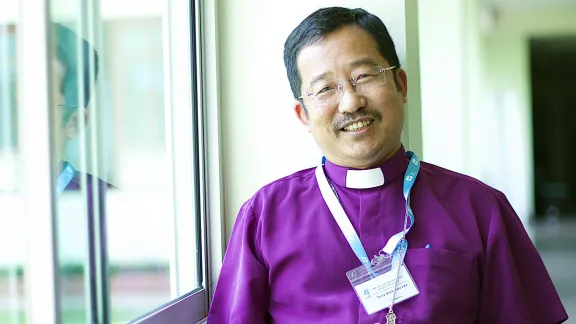
Bishop Terry Kee, Lutheran Church in Singapore Photo: LWF/Romans Wong
Voices from the Communion: Bishop Terry Kee
(LWI) - As a young pastor in Singapore, Rev. Terry Kee discovered he had a gift for promoting dialogue within divided congregations. It is a gift he has continued to develop and use to great effect during his ministry as bishop of the Lutheran Church in Singapore (LCS) and as a leading figure for ecumenical and interreligious relations in his country.
Originally a part of the Lutheran Church in Malaysia, the LCS was established in 1997 and today numbers around 3,000 members. Kee was one of the first two Singaporeans to be ordained as Lutheran pastors in 1987.
As he prepares to step down from his position as head of the LCS, Bishop Kee shares some of the past and present challenges facing his church in the multi-ethnic, multi-religious nation.
Your church became independent from Malaysia less than 25 years ago – tell us something about its history?
The church in our region started when Christian missionaries of different denominations were expelled from China in the early 1950s. These missionaries had spent time learning the Chinese language and culture, so they began looking for opportunities to work among the Chinese in the diaspora.
At the same time, The Lutheran World Federation convened a meeting for missionaries in Malaysia, the first Southeast Asia Lutheran Consultative Conference, which was also looking at ministry among the Chinese living outside of China.
At that time, British authorities in Malaysia were struggling against communist Chinese insurgents along the border areas so they decided to build so-called New Villages and relocate local people there. They saw religion as a good deterrence against communism, so made available free land for the construction of churches, schools and clinics. Half a year later in 1953, the first Lutheran missionary arrived in Malaysia and began developing congregations, both in those rural villages and in urban areas where people migrated for education and employment.
When and why did the church in Singapore decide to separate from Malaysia?
Our country became independent from Malaysia in 1965. After that, many entities began to separate including some churches, but we continued to operate as one, remaining as part of the church’s southern district.
Over the years though, practical differences in the education system and increased government control over finances flowing in and out of the country, began to create administrative challenges for us.
There were no conflicts between Malaysian and Singaporean church leaders, but there were more and more regulations making it difficult for us to operate as one. So, we felt that perhaps it was time to begin to separate along national lines, but we will still remain in partnership and support each other, as and when we can.
Almost a quarter of a century on, what does the church in Singapore look like today?
We have 24 ordained pastors and six congregations--five Singaporean and one Thai congregation. When I became bishop in 2009, they were seven, because tensions within one of the churches had led to a breakaway. I saw the need to clear up that conflict and had conversations with their leaders and, thanks be to God, a few years ago the council of the breakaway congregation decided to go back to where they came from. So, we have lost a congregation, so to speak, but not its members!
Every church has at least two ministries, one in English and the other in Chinese, while some also include one of the major Chinese dialects, Hokkien, usually spoken by older people who have not learned Mandarin or English. These different ethnic ministries have their own pastors and council to support them, but also work together on a joint council.
Are these congregations growing or shrinking in size at the present time?
They are quite stable in size. If you look within last the last four or five years, you will see that we have lost some members to other churches, but we have also had some baptisms and so overall, we have seen a very small increase in numbers.
You have served two terms as head of the National Council of Churches of Singapore (NCCS), which includes many different Christian groups. How closely do you work together across the different denominations?
Singapore as a small island city state has its advantages. The heads of denominations meet regularly in the Governing Board of Trinity Theological College, Executive Council of the National Council of Churches besides meeting for prayers once a month.
We had also organized joint events with the most memorable being the National Jubilee Thanksgiving as well as the Celebration of Hope rally at the National Stadium.
Singapore is a majority Buddhist nation, but it is also one of the most religiously diverse countries of the world. How would you describe relations with other religious communities?
Improving, but I would say still some way to go. I am part of an interfaith organization committed to promote understanding and friendship between people of different faiths.
There was a grassroots organization initiated by an insightful Muslim, Abdul Aleem Siqqique who called other religious leaders together to respond to communal tensions. It was called the Inter-Religious Organization (IRO) and it began with five faith communities, but now we are 10 registered religions.
How have you been affected over the past year by the COVID-19 pandemic?
Singapore was one of the first countries after China to be affected and we had our first cases on 19 January. The government made a major effort to suppress local transmission through lockdown, but Singapore is a very busy and important trade route so we cannot simply close our borders. Many citizens returned from overseas and were required to self-quarantine, but the virus leaked out into the community.
We have about half a million migrant workers, many of them living on specially built housing estates with dormitories for up to 25,000 people. The infection started to spread because of the high density there and although the government rolled out free testing and medical care, the high numbers that we saw in the second phase were from people living in these dormitories. But out of 59,000 infections, we only had 29 deaths due to the good health care in Singapore. Now infection rates are dropping, and we have strict quarantine measures for new arrivals, so as of two weeks ago, we have had no new local transmissions.
How has the church managed to adapt to the challenges?
When we first went into so-called Code Orange, we were allowed limited numbers in churches, but we realized there could be further restrictions or a total ban on services. Some churches, especially the megachurches, were very well equipped with technology and expertise, so they gave free training on what equipment to buy, how to record and edit or live-stream and this was very helpful. After 10 days, as infections increased, the circuit breaker measures were implemented which include the suspension of on-site religious activities for all religions.
The Lutheran Church in Singapore made a decision to run one live-streamed worship service for everyone in April and then allow each congregation to stream their own services in May when they were properly prepared.
We also advised churches to apply for QR codes to have digital banking facilities, but many older members are not so technical savvy and don’t have smart phones. One of our pastors also did audio recordings of services and sent these files to older members to include them too. We encouraged people to either use the scan codes to make offerings during the services, or to put money in an envelope and set it aside. One pastor recounted that when on-site services began again with limited numbers, a congregation with less than 50 elderly members brought more than 10,000 dollars in these envelopes! Overall, our income is still a bit lower than before the pandemic, but we have less expenditure with more online activities, so we are alright for the year. However, the pandemic has resulted also in the loss of jobs for many, the church has stepped up to provide support for families who are affected.
Are people returning to church again now?
We made a decision not to do virtual Holy Communion, as some were doing, so there is a real hunger for the sacrament when people come back. Some still feel it is unsafe, others miss the fellowship after worship, but many who have returned said that they were moved more than they had anticipated. They told us that before the pandemic, they took things for granted but now, despite all the social distancing and face shields, they found it to be a very moving experience.
But will we be able to bring all the sheep back to the fold? One congregation has seen some family members, who had never been to church before, become interested by watching worship on zoom and sign up to our basic education program. Another pastor, who struggled to get young families to join any activities, now organizes a popular weekly zoom class at 9.30 p.m. so that parents can put their kids to bed first. Another is doing daily online devotions and has also had a really positive response. So, there are opportunities, as well as challenges.
As you come to the end of your time as bishop, what plans do you have for the future?
In all my years of ministry, I have been assigned to many different places, but always with one thing in common, that is the need to bring reconciliation. Early in my ministry, I was used by the Lord to ease tensions between congregations in the same church. After that I was assigned to a church that had issues between charismatics and others before serving in a congregation where there were great tensions between the older and younger generations. For ten years, I also worked on church planting overseas in Thailand before being called back to Singapore in 2006 and elected bishop in 2009.
In all my years, I had always submitted to the call and assignment of the church according to her needs. I am willing to serve in any congregation or ministry that the church would assign me, including overseas mission.
The NCCS has created a new post of interfaith ambassador for me, which I see as being a bridge of peace and understanding between Christianity and other religions and the IRO is hoping that I can continue to serve in leadership with them too. I enjoy it all and I will continue to go wherever God is calling me to serve.
Bishop Kee will serve his term of office until the LCS elects a new bishop in May 2021.
LWF/P. Hitchen
Established in 1997, the Lutheran Church in Singapore has nearly 3,000 members and it joined the LWF in 1999. Organized in six congregations—five Singaporean and one Thai—it has 24 ordained pastors, including the head of the church Bishop Terry Kee.
The Lutheran World Federation is a global body that shares the work and love of Christ in the world. In this series, we profile church leaders and staff as they discuss topical issues and set out ideas for building peace and justice in the world, ensuring the churches and communion grow in witness and strength.


